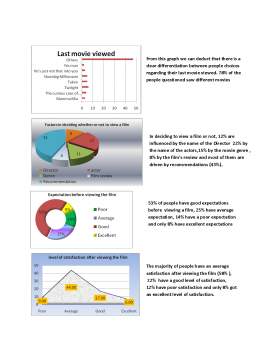Extras din proiect
INTRODUCTION
Research methods is a collection of information, it is more than just reading a few books or articles, talking to a few people or asking people question and at the end find the problem or solve the problem. Research provides the purpose the needed information that guides managers to make in formed decisions to successfully deal with problems. The information provided could be the result of a careful analysis of data gathered firsthand or of data that are already available (in the company, industry, archives, etc). Data can be quantitative (as generally gathered through structured questions) or qualitative (as generated from the broad answers to specific questions in interviews or from responses to open-ended questions in a questionnaire, or through observation, or from already available information gathered fro various sources).
Here we are doing the critically analysis Sedgwick’s (2007) theory about pattern of consumer expectation with respect to film going. Film is one of the fresh entertainment for human being. It is an experiential divide exists of awareness, this are expectation and realization. Advertising and production values play an important role in shaping the expectation. The accumulation of experience serves as an ongoing basis for decision-making. Marketing efforts of studio to influence the filmgoer and also affecting the consumer’s choice. Film revenues are related to film costs, while an upward trend can be observed between the two variables, magnitude of the variance rules of statistical significance. Normally consumers engage in a two-part decision-making process: first stage involves the use of some form of personal heuristic to reject those films released onto the market that, for whatever reason, signal meagre levels of cinematic pleasure for the filmgoer. In the second stage, the consumer has arrived at a final choice set, consisting of a small number of films which the consumer evaluates in a more considered fashion.
We have tried to examine the importance of the unique attributes of films which help respondents decide on a movie and how accurate the consumers are when setting up their expectations, based on the data we collected from a number of film goers’ experience
LITERATURE REVIEW
Consumer behaviour is one of the subjects that are often reviewed as it is believed that a better understanding in consumer behaviour will result in higher profits. This descriptive research will explore the complexity of consumer behaviour factors that influence the choices of consumers related to film going. John's theory suggests the distribution of differences between a filmgoer's expectations and experience. As he has mentioned Hoskins, McFayden, and Finn's (1997) argument that a film is a product that consumers pay even before enjoying it completely and has little guidance in choosing which movie to attend than other products where a consumer can search and experience therefore, filmgoers endure uncertainty.
An argument proposed by John Sedgwick in his research proposal, A Shacklean Approach To the Demand for Movies (2007) states that film goers often make mistakes while selecting the films they watch and there is a considerable difference between what they expect and what they realize from the films. The research paper (theory) here points out that individual consumers use their imaginations to deal with the uncertainty associated with choosing the films they go to see theatrically. The utility of expectations and realization consistently diverge as consumers make mistakes in choosing between films and these mistakes or errors are indeed randomly distributed.
The next most important aspect of John's theory is his view on "film as a commodity-type" wherein the distinction between films and other commodity types are clearly defined. Films are not only consumed in the mind of the viewer but also the images in the film are infinitely reproducible. Since, the ordering of the images into the sequenced continuity makes the film meaningful, the consumers cannot have the complete idea of the oral/visual utility that they are going to experience. Also, if we consider film as a commodity, the element of diminishing utility is attached to it which states that once consumed in theatrical release, films are rarely revisited theatrically by consumers. In forming their expectations, consumers interpret information signals made available by a film’s producers/distributors. These signals are likely to consist of markers such as actor/director stars and genre-type, each of which, and in combination, becomes a factor within a consumer’s mentalframework of evaluation, which in turn is a substructure within that person’s world-and-life-view (weltanschaunng) (Albert, 2005).
As per the theory of consumers having a fixed level of expectation over a period of time, say a year, the endogenous factor may affect his expectations over a period of time and the expectations from the films they watch may change. But at any given point of time film consumption may result in one of the three possibilities, i.e. (i) diminished utility (ii) fulfilment, or (iii) enhanced utility. The diminished utility can range from mild disappointment or a sense of loss to the depths of dispiritedness and an enhanced utility can range from slight pleasure to the heights of exhilaration. A hypothetical ex post-frequency distribution of the difference between the expectations and satisfaction of a cinematic utility of a particular filmgoer for a period of time can be obtained.
Consumer tastes are continuously changing from time to time. As per Sedgwick 2007 pg 80, “taste formation and hence expectations, involve both exogenous and endogenous aspects of change”. Key to understanding the uncertainty faced by filmgoers is their inability to conceive ex ante the full range and intensity of sensory experiences entailed in the act of film consumption. The accumulation of experience thus serves as an ongoing basis for decision-making.
Preview document
Conținut arhivă zip
- Cercetare in Comportamentul Consumatorului de Cinematograf.doc




















